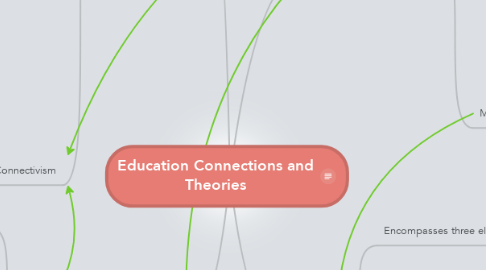
1. Learning Theories
1.1. Cognitivism(Cognitive Load Theory)
1.1.1. Replaced behaviourism as the major leanring theory in the 1960's
1.1.2. Focuses on "opening the black box" of the mind, the mind as a computer
1.1.3. People interpret information and stimulus and act accordingly
1.1.4. We store information in long term memory
1.1.5. Overloading the memory impairs learning
1.1.6. Teachers should provide so much information in one class
1.2. Constructivism
1.2.1. Learning is building connections by actively interacting with the environment
1.2.2. Learning involves constructing ones own meaning
1.2.3. In the classroom students should work through hands on activities that helps them work through problems through experiential knowledge development as well as theoretical learning
1.2.4. The teacher is the guide on the side, rather than the sage on the stage
1.3. Connectivism
1.3.1. Students need help to form learning networks and develop the skills to use technology tools
1.3.2. Once they have these skills teachers provide the conditions and activities for students to make their own discoveries and learning
1.3.3. Students have to form answers on their own by discovery
2. Philosophy of Teachnology
2.1. Evaluates educators views of technology in the same fashion as educators' views about their personal teaching styles
2.2. Teachers can review and reflect on their own personal ideas about how and why technology should be used in the classroom in either written or digital form
2.3. As time progresses can be used as rationale for why a certain technology is used in the classroom as opposed to others
2.4. Carries over into many domains including professional development
2.5. Has us seriously evaluate the technology we use so that it does not simply become a gimmick. There is serious educational value
2.5.1. http://twt.weebly.com/my-teaching-philosophy.html
3. Technology Theories
3.1. SCOT
3.1.1. Social Construction of Technology
3.1.2. Only human need and desire shapes the direction and shape of technology
3.1.3. Analyzes why certain technologies take root and others do not
3.1.4. Often technology advances due to perception of the best option rather than the best option
3.1.4.1. Oil and natural gas continue to be the primary development technologies for fuel even though other option could be better with a few years of development
3.1.4.2. Apple products are wildly more expensive than other devices with similar specifications but sell based on reputation and consumer preference
3.2. Media Ecology
3.2.1. Humans are affected by technology and our society changes as we are by technology
3.2.2. Technology is largely responsible for the ways we perceive the world
3.2.3. “a new state of consciousness, the ultimate in open-system awareness. Its thrust is the dialectical opposite of the isolating thrust of writing and print” Lance Strate. http://cscc.scu.edu/trends/v23/v23_2.pdf
4. TPACK
4.1. Encompasses three elements
4.1.1. Pedagogy
4.1.2. Content Knowledge
4.1.3. Technological Knowledge
4.2. Uses a Venn diagram to show the intersecting pathways of the three areas of expertise
4.2.1. http://tinyurl.com/a4rzm77
